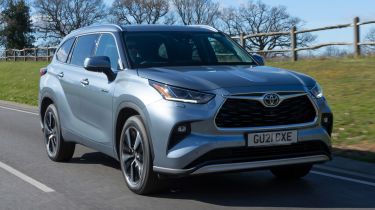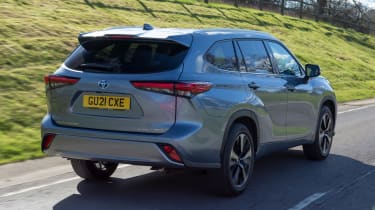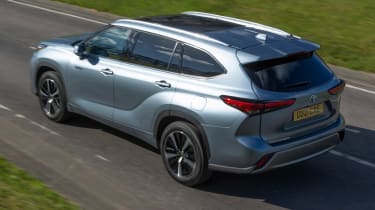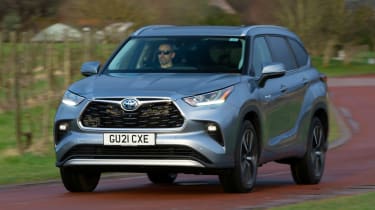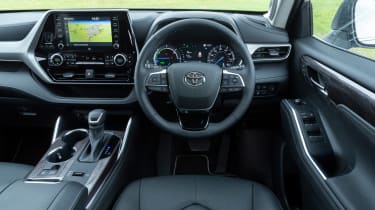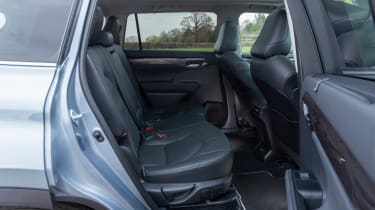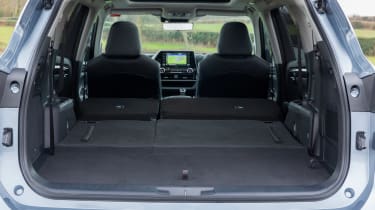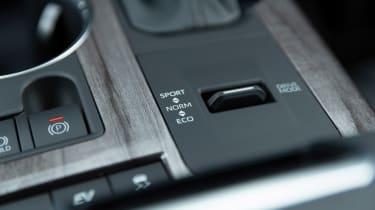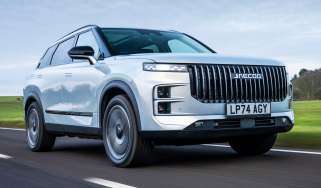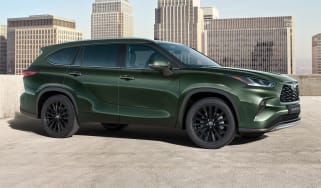Toyota Highlander SUV review (2021-2023)
"The Toyota Highlander is a spacious and reliable large SUV that’s comfortable but lacklustre to drive"
Pros
- Flexible seating
- Comfortable
- Hybrid powertrain
Cons
- Mediocre infotainment
- One engine choice
- Dull to drive
The Toyota Highlander is a large seven-seater SUV that sits at the top of the Toyota range. You could argue that this title should go to the Toyota Land Cruiser but that car is aimed at a different audience - it’s much more focused on off-roading, while the Highlander is aimed at big families, and Toyota has prioritised comfort and efficiency.
Key rivals for the Highlander include the Kia Sorento, Skoda Kodiaq and Peugeot 5008. These models have a very similar list of plus and minus points - they’re all comfortable and practical but not exceptionally efficient nor particularly fun to drive. The Highlander isn’t much different, though its hybrid setup means it’s actually relatively efficient.
The car uses a 2.5-litre petrol engine along with an electric motor and a small battery. This means it can drive on electric power alone but only for very short distances and since you can’t plug it in, the engine charges the battery. It should be capable of 40mpg, similar to the most efficient diesel engines in rivals.
The Highlander is a big SUV, nearly five metres long, and that means there’s plenty of space inside, even in the back row. The middle row can slide to create more legroom and boot space is good, even with all the seats in place. There’s a decent 332 litres of space in seven-seat mode, which is a little less than some family hatchbacks offer, and 658 litres with the rearmost seats folded.
 The 10 best large SUVs on sale in 2025
The 10 best large SUVs on sale in 2025
The interior is a comfortable place to spend time, with some pleasant soft-touch materials and excellent build quality, but we wish the infotainment setup felt more cutting-edge. There are two trim levels, called Excel and Excel Premium, and the former is our pick. It gets everything most buyers will need, including heated seats, a JBL stereo, three-zone climate control, a panoramic sunroof, leather upholstery and a powered boot.
We're glad Toyota has finally decided to bring the Highlander to the UK, more than two decades after it went on sale elsewhere. It's a competent large SUV that should appeal to families who need lots of space but aren't too fussed about venturing off road. All it needs now is a more impressive infotainment system to really upset its rivals.
MPG, running costs & CO2
Buyers won't need to worry about examining technical specifications because the Highlander only comes with one hybrid powertrain. It's based around a 2.5-litre petrol engine, an electric motor and a small battery, and doesn't require plugging in.
Instead, rather like the Prius, the Highlander harvests some energy every time it slows down, which charges the battery ready for the electric motor to give the petrol engine a helping hand. The electric motor can propel the Highlander by itself but only for short distances at low speeds - typically in heavy traffic or car parks. There's an EV button to lock it in this mode at speeds of up to 38mph for as long as the charge lasts or until the driver presses the throttle too hard.
Officially the fuel-efficiency figure is 39.7mpg, which seems realistic, as we managed just over 40mpg during our test drive. CO2 emissions of 160g/km also mean the Highlander is competing with diesel rivals for running costs, rather than plug-in hybrids. The Kia Sorento - one of our favourite seven-seat SUVs - is available as a hybrid, returning up to 40.9mpg and emitting 160g/km.
Engines, drive & performance
The petrol engine produces 188bhp, which is bolstered to 244bhp by the electric motor. It's enough to give the Highlander a respectable 0-62mph time of 8.3 seconds, making it slightly quicker than the Kia Sorento hybrid. The two cars feel rather different to drive because while the Kia uses a six-speed automatic transmission, the Toyota gets a CVT transmission. If you prefer the feel of gear changes, there's a Sport mode and paddles behind the steering wheel that create artificial steps in the fluid gear ratio, but we found it better to just leave it in Normal or even Eco mode. As with most CVT-equipped models, the Highlander is at its best when driven fairly gently and smoothly, especially around town.
Sitting on a stretched version of the building blocks that make up the RAV4, the Highlander is smooth but its tall body and heavy weight means it tends to lean while cornering. Its steering is pleasingly accurate, though, making it easy to position the Highlander on the road, despite its size.
Interior & comfort
The Highlander is designed to be more comfortable than sporty, and it's very comfortable around town and on the motorway. Buyers of large SUVs expect a premium interior, and while the Toyota scores in some areas, it also fails to impress in others. We like the soft-touch materials used for the higher up in the cabin, the soft leather seat upholstery and build quality.
Technology is less impressive, largely because the eight-inch Touch 2 infotainment system feels dated compared with the offerings from rival manufacturers like Kia and Skoda. Oddly, Highlanders in the US get a new 12.3-inch widescreen setup that's not yet offered here.
There are two trims, called Excel and Excel Premium, with the former likely to be most popular. It includes leather upholstery, heated front seats, a heated steering wheel, triple-zone climate control, a panoramic roof and powered boot. Reversing sensors and a rear-view camera are also fitted. The media system does come with Apple CarPlay and Android Auto, a wireless smartphone charger and a JBL sound system boasting 11 speakers. An upgraded Excel Premium trim costs around £2,000 extra, adding a head-up display, 360-degree camera view, and heated and ventilated front seats.
Practicality & boot space
Unlike some large SUVs, the Toyota Highlander comes with three rows of seats as standard, which is a big tick in the box for families. Not only are there seven seats but they're highly configurable too. The middle row can slide 180mm on runners, creating lots of space and legroom for passengers when the Highlander is used as a five-seater. Push the middle seats forwards and it improves access and space for the third row, and all seven seats have a reclining function.
With five seats in place, the loading area is completely flat, with a competitive 658 litres of space up to the parcel shelf. Fold the middle row down and it's possible to use 1,909 litres of space if you don't mind loading to the roof. Even with all seven seats in place, boot space doesn't become non-existent, with a supermini-like 332 litres still available. The Kia Sorento has a smaller 608-litre boot but it counters with 1,996 litres of space with its seats stowed away.
As well as having a spacious interior, the Highlander's designers have clearly considered family life, because there are lots of storage spaces all around the car. There are large door bins, a big storage cubby sits in the middle of the car and there's a deep glovebox. It's also possible to hide valuables out of sight under the boot floor, and there are USB sockets for front and second row passengers. Visibility is excellent for the driver and passengers, apart from out of the rear window, where the rear-view camera comes in handy.
The Highlander is able to tow a 2,000kg braked trailer or 700kg unbraked trailer, which beats the 1,650kg figure of the hybrid Kia Sorento, and should be more than enough to tow a caravan.
Reliability & safety
Toyota has an excellent reputation for reliability, and the brand came fifth out of 30 manufacturers overall in our 2021 Driver Power owner satisfaction survey. Its hybrid powertrains and CVT gearboxes in particular are renowned for rarely going wrong and costing little to maintain. It's also reassuring to note that the Toyota C-HR came fourth out of the top 75 cars in the survey, as it has many parts in common with the Highlander.
Euro NCAP hasn't delivered its safety rating for the Highlander yet but it's fitted with Toyota's Safety Sense suite of technology as standard. This includes autonomous emergency braking that can detect pedestrians and cyclists, assist with steering in an emergency and alert the driver to road signs. It also includes lane departure alerts and adaptive cruise control that can adjust the car's speed for corners.

